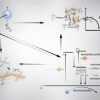singlet fission
 Molecular Control of Triplet-Pair Spin Polarization and Its Optoelectronic Magnetic Resonance ProbesConspectus Preparing and manipulating pure magnetic states in molecular systems are the key initial requirements for harnessing the power of synthetic chemistry to drive practical quantum sensing and computing technologies. One route for achieving
Molecular Control of Triplet-Pair Spin Polarization and Its Optoelectronic Magnetic Resonance ProbesConspectus Preparing and manipulating pure magnetic states in molecular systems are the key initial requirements for harnessing the power of synthetic chemistry to drive practical quantum sensing and computing technologies. One route for achieving Triplet-Pair Spin Signatures from Macroscopically Aligned Heteroacenes in an Oriented Single CrystalThe photo-driven process of singlet fission generates coupled triplet pairs (TT) with fundamentally intriguing and potentially useful properties. The quintet 5TT0 sublevel is particularly interesting for quantum information because it is highly
Triplet-Pair Spin Signatures from Macroscopically Aligned Heteroacenes in an Oriented Single CrystalThe photo-driven process of singlet fission generates coupled triplet pairs (TT) with fundamentally intriguing and potentially useful properties. The quintet 5TT0 sublevel is particularly interesting for quantum information because it is highly Singlet fission, a process that splits a singlet exciton into a biexciton, has promise in quantum information. We report time-resolved electron paramagnetic resonance measurements on a molecule, TIPS-BP1′, designed to exhibit strongly state-
Singlet fission, a process that splits a singlet exciton into a biexciton, has promise in quantum information. We report time-resolved electron paramagnetic resonance measurements on a molecule, TIPS-BP1′, designed to exhibit strongly state- Short coherence times present a primary obstacle in quantum computing and sensing applications. In atomic systems, clock transitions (CTs), formed from avoided crossings in an applied Zeeman field, can substantially increase coherence times. We show
Short coherence times present a primary obstacle in quantum computing and sensing applications. In atomic systems, clock transitions (CTs), formed from avoided crossings in an applied Zeeman field, can substantially increase coherence times. We show Singlet fission is a photoconversion process that generates a doubly excited, maximally spin entangled pair state. This state has applications to quantum information and computing that are only beginning to be realized. In this article, we construct
Singlet fission is a photoconversion process that generates a doubly excited, maximally spin entangled pair state. This state has applications to quantum information and computing that are only beginning to be realized. In this article, we construct Singlet fission, where an electronically excited singlet on one chromophore converts into a doubly excited state on two, has gone from a curiosity in organic photophysics to a potential pathway for increasing solar energy conversion efficiencies.
Singlet fission, where an electronically excited singlet on one chromophore converts into a doubly excited state on two, has gone from a curiosity in organic photophysics to a potential pathway for increasing solar energy conversion efficiencies. In molecular crystals that exhibit singlet fission, quantum yields depend strongly on intermolecular configurations that control the relevant electronic couplings. Here, we explore how noncovalent interactions between molecules and surfaces
In molecular crystals that exhibit singlet fission, quantum yields depend strongly on intermolecular configurations that control the relevant electronic couplings. Here, we explore how noncovalent interactions between molecules and surfaces We present a model to describe collective features of singlet fission in molecular crystals and analyze it using many-body theory. The model we develop allows excitonic states to delocalize over several chromophores which is consistent with the
We present a model to describe collective features of singlet fission in molecular crystals and analyze it using many-body theory. The model we develop allows excitonic states to delocalize over several chromophores which is consistent with the

